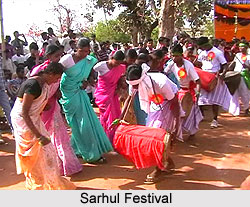 Culture of East Singhbhum District is rich and diverse and mainly tribal in nature. A unique tribal folk tradition exists in this district of Jharkhand. The valleys of Subernarekha River and Kharkai river and Dalma hill are inhabited by Proto Austroloid and mixed Dravidian communities from the time immemorial. Culture of East Singhbhum District comprises ancient as well as aboriginal elements. Since the land has not been completely dominated or influenced by any foreign culture, it has maintained its uniqueness and identity of the dignified folk culture which is reflected through its festivals and festivities.
Culture of East Singhbhum District is rich and diverse and mainly tribal in nature. A unique tribal folk tradition exists in this district of Jharkhand. The valleys of Subernarekha River and Kharkai river and Dalma hill are inhabited by Proto Austroloid and mixed Dravidian communities from the time immemorial. Culture of East Singhbhum District comprises ancient as well as aboriginal elements. Since the land has not been completely dominated or influenced by any foreign culture, it has maintained its uniqueness and identity of the dignified folk culture which is reflected through its festivals and festivities.
The languages in East Singhbhum District mostly come from three distinct stocks. One is the Munda Languages which includes Ho, Mundari, Santhali Language, Mahili, Bhumij and Kharia Language. The other is the Dravidian Tribal Languages which includes Oraon, Telugu Language, Tamil and Gondi Language. The rest are of the Indo Aryan languages stock which includes Hindi language, Urdu language, Bengali language, Oriya language, Gujrati language, Nepali language, Marwari language, Punjabi language, etc. The folk literature and songs among the Adivasis have been preserved from generation to generation by repetition even in the absence of the written script. The non-Adivasi folk literature and songs have been carried to Singhbhum either from other parts of Biharr or Orissa. Cinema songs have not gained that popularity which they have got in the other parts of Bihar.
The pastoral songs are sung by women while working in the field at the time of transplantation of paddy and at the time of harvesting. The theme of the songs relates generally to love or to some incident of the past. They are sweet and melodious. Some of the major festivals of East Singhbhum District are Sharhul, Chait-Ganjan, Ind-Karam, Bandna, and Makar or Tusu Parab. Tribal communities of East Singhbhum District are very fond of ornaments. They inherently use various types of ornaments, like the ornaments made of bead, precious stones metals like gold and silver. Design is very simple like their art.

The indigenous art of East Singhbhum District originated with folk spirit of Jharkhand. So, it is undividable from original Jharkhand folk art. The heritage of art is properly maintained by the indigenous people of the region. The folk art of Singhbhum embraces articles of daily use as well as those made on special occasions. The most important art forms are their wall embellishment and mask for Chhau (Indian folk dance). Traditionally they use various art forms like body painting (tattoo), stone cutting, bull painting (during Bandna), sculpting horse, elephant etc. for ritual purposes. The methods and materials used are traditional and handed down in the families, generation after generation and still persist with little alteration. The quality of freshness, spontaneity, sincerity and simplicity of their art are appreciable.
Scroll Painting: Folk painters of the district known as ` Paitkar Paintings ` make scroll painting. Mainly they illustrate the primitive concept of "life after death".
Chhau Mask: This mask has its own significance. The papier machei of Saraikela is popular for the mask for Chhau Dance. The methods and materials are separate from each other.
Wooden Work: Jharkhand region was also known as Jungle Mahal because of its dense forests. The forests are rich with quality wood and the wood is used for producing the equipment required in housing, farming, fishing, etc. The artisans of this region have explored creativity in wooden work. Beautifully decorative door panels, toys, boxes, and other household articles are some finest examples of wood craft.
Bamboo Works: The bamboo found in the thick forests of Jharkhand is of special quality. The artisans use these bamboos in different artifacts like, basket, hunting and fishing equipments.
Potteries, weaving and stone carving are other popular art forms prevalent in East Singhbhum District. Different income-groups of people in the urban areas have a somewhat different type of daily life. But life in the rural areas is of more or less the same pattern for all classes.



















